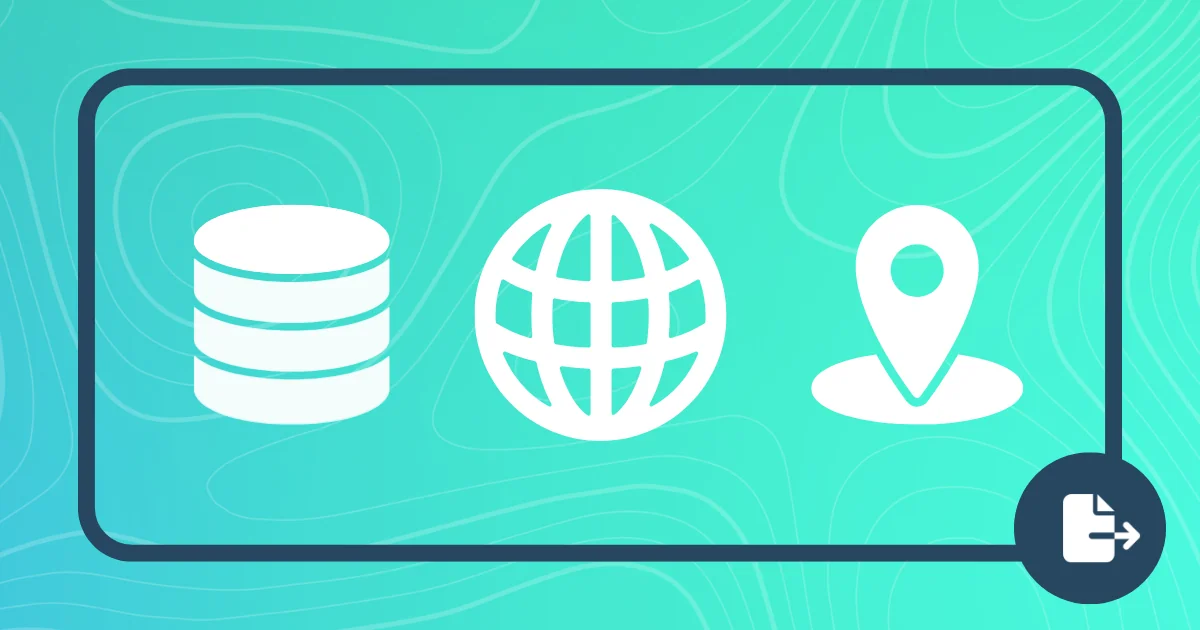GIS files are often a required component of environmental reports, whether you’re delineating wetlands, mapping streams, assessing environmental impacts, or preparing regulatory submissions.
GeoJSON, Shapefile, and GeoDatabase formats each suit specific scenarios and applications. Understanding these differences will help ensure your environmental reports meet all requirements, and enable effective communication with colleagues, regulators, and clients—saving time and clearly conveying your findings.
Let’s explore how to select the best GIS export type for your next environmental project.
1. GeoDatabase (GDB)
A File Geodatabase (GDB) is Esri’s modern spatial database format. It supports advanced GIS data types, domains, versioning, and more.
GDB is Ecobot’s recommended GIS export for most scenarios, thanks to lengthier character limits, and support for a variety of complex data types. Choose GeoDatabase when collaborating closely with GIS teams who manage data-rich permitting, restoration, or monitoring projects over time.
Best for:
- Long-term monitoring with frequent updates
- Projects requiring topologies or subtypes
Strengths:
- High performance with large datasets and complex spatial relationships
- Supports complex spatial logic and constraints
- Stores multiple feature classes in one container
Limitations:
- Not human-readable
- Mostly usable only within Esri environments
- Not ideal for lightweight sharing
2. Shapefile
The Esri Shapefile has been around since the early ’90s. It remains widely used in consulting and government workflows. It’s a multi-file format (.shp, .shx, .dbf, etc.) that stores geometric location and attribute information.
Shapefiles are often a safe choice if you’re submitting GIS data to a DOT, USACE, or local government agency. However, due to the character limits, field data will be truncated within your Shapefile.
Best for:
- Compatibility with legacy systems
- Regulatory submissions that require it
- Consultants working in Esri ArcMap or QGIS
Strengths:
- Universally supported
- Compact and fast
- Accepted by most permitting agencies
Limitations:
- File size and field name limits (e.g., 10-character attribute field names)
- No support for complex relationships or topologies
- Doesn’t store projection info directly (needs a .prj file)
- Null values not supported
3. GeoJSON
GeoJSON is a JSON-based open standard for encoding a variety of geographic data structures. It’s easy to read, small in size, and plays nicely with modern web mapping platforms like Leaflet, Mapbox, and Esri’s ArcGIS Online.
Use GeoJSON when sending quick previews to clients or team members who want to drop data into a web map viewer without heavy GIS tools.
Best for:
- Simple spatial visualizations
- Web mapping applications
- Internal team review and quick previews
Strengths:
- Human-readable and easy to debug
- Compatible with most web-based tools
- Great for prototyping or sharing simple map data
Limitations:
- Doesn’t support advanced spatial types like topologies or network datasets
- Limited attribute schema compared to geodatabases
Summary Table
| Format | Best Apps/Platforms | Use Case |
|---|---|---|
| GeoDatabase | ArcGIS Pro, ArcGIS Enterprise, ArcGIS Online (limited), ArcMap | Advanced spatial logic, ongoing monitoring projects, projects of all sizes |
| Shapefile | ArcMap, ArcGIS Pro, QGIS, Global Mapper, MapInfo, AutoCAD Map 3D, Civil 3D | Regulatory submissions, traditional GIS workflows |
| GeoJSON | Mapbox, Leaflet, OpenLayers, ArcGIS Online (partial), QGIS, Python (GeoPandas) | Lightweight sharing, client previews, web maps |
Ecobot supports each of these export types, plus .csv files. Want to streamline your environmental assessment workflows and easily produce GIS files? It’s free to sign up: https://manager.ecobot.com/get-ecobot/



